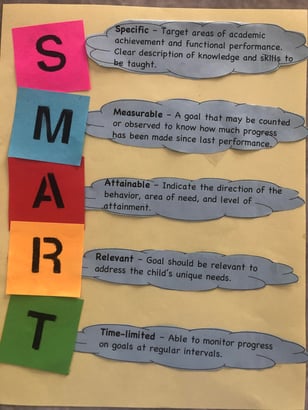As special education practitioners, we know that writing Individualized Education Plan (IEP) goals based upon evidence-based instructional strategies are the gold standard to support student learning for college- and career readiness. By setting Specific, Measurable, Attainable, Relevant, and Time-limited goals, all IEP team members have a clear sense of the target to meet before the next annual review.
 Definition
Definition
SMART is a mnemonic acronym used in a variety of settings, providing benchmark goals and measurements. IEP team members may also use this tool to write better annual goals:
- Specific - The goal identifies the areas of need (e.g. academic or behavioral) and functional performance;
- Measurable - The goal is observable and must be measured and collected to determine the student’s progress;
- Attainable - The goal indicates the student’s expected annual progress;
- Relevant - The goal addresses the child’s specific deficits in knowledge, skills, or behaviors necessary for school success;
- Time-limited - The goal is written for a one-year time frame to improve present levels and a child’s academic achievement or behavior;
Examples
8th-grade math
By (date), (name) will increase math skills by solving two-step equations as measured by teacher-made assignments and student work samples, with no more than 4 errors in 25 problems.
|
Specific
|
Measurable
|
Attainable
|
Relevant
|
Time-limited
|
|
The student will solve systems of equations with two variables
|
Using teacher-made assignments and student work samples
|
With no more than 4 errors in 25 problems
|
Meets 8th grade-state standards for expressions and equations
|
The goal will increase student’s ability to solve more complex linear equations within one year
|
5th-grade reading
By (date), (name) will use graphic organizers to draw the main idea and 3 supporting details for one paragraph of informational text with no more than 4 errors after reading 20 passages, as measured by teacher-made assignments and student work samples.
|
Specific
|
Measurable
|
Attainable
|
Relevant
|
Time-limited
|
|
Using graphic organizers, students will draw the main idea and 3 supporting details about informational text
|
As measured by teacher-made assignments and student work samples
|
With no more than 4 errors after reading 20 informational text passages
|
Meets state reading standards for 5th-grade comprehension of informational text
|
The goal will increase student’s ability to explain how the author reasons and uses evidence to support a claim within one year
|
Behavior
By (date), (name) will initiate his/her work as evidenced by writing relevant words or numbers on his/her paper within one minute of an assignment being presented, with a minimum of 20 recorded opportunities over two months, as measured by observational assessments.
|
Specific
|
Measurable
|
Attainable
|
Relevant
|
Time-limited
|
|
The student will initiate work within one minute of an assignment being presented
|
As measured by teacher observations and student performance assessments
|
20 recorded opportunities over two months
|
Supports student’s ability to be on task
|
The goal will increase student initiation of assigned classroom work within one year
|
Summary
Using the SMART technique will guide IEP teams to write high-quality, legally defensible, IEP goals every time.
Author: Judith Magee, MA, Education Specialist

.png)
 Definition
Definition